Page 315 of 352 pages « First < 313 314 315 316 317 > Last »
Abolitionists’ leaflet

Description:
Leaflet published by the Plymouth Abolitionists, 1788, showing a plan of the Liverpool slave ship Brookes . The plan shows how the enslaved Africans were positioned inside the ship.
Creator: Plymouth Abolitionists
Date: 1788
Copyright: Copyright BCC Record Office
Object ID:17562/1
Conveyance of slaves
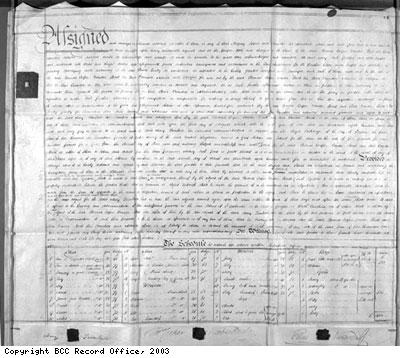
Description:
Document: Conveyance of slaves in Georgia, North America.
Date: 1805
Copyright: Copyright BCC Record Office
Invoice for seeds
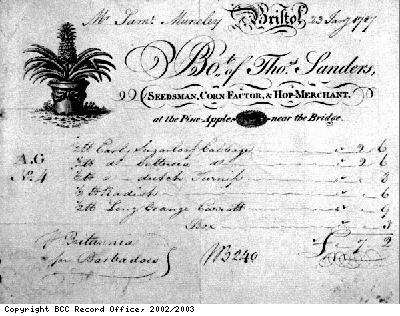
Description:
Invoice from Thomas Saunders, seedsman, for seeds sent to the island of Barbados in the Caribbean.
Creator: Thomas Saunders
Date: 1787
Copyright: Bristol Museums, Galleries & Archives
Playbill

Description:
Playbill for comic opera, Inkle and Yarico.
An Indian woman is sold into slavery on Barbados by the man she had rescued and protected from her countrymen when he was shipwrecked. He then repented of his action towards the woman he had loved, redeemed her and married her.
Inkle and Yarico is a comic opera, which was written by George Colman the Younger in 1787.It is based on a supposedly true story told in Richard Ligons True and Exact History of the Island of Barbados.
A young man was shipwrecked on the South American coast and his life was saved by a young Indian woman.
He got off the island, taking her with him, and then sold her into slavery in Barbados.
This story was romanticised by Steele, writing in the Spectator in 1711.
Colman adapted Steeles story into his comic opera. It was very popular and was performed many times at different London theatres.
In Colmans version, Thomas Inkle, a young Englishman, is taking his fiance out to her father, the Governor of Barbados.
He is lost overboard with his servant and is marooned on an island.
They are saved from the cannibal locals by a young Indian woman, Yarico, and her servant.
Inkle and Yarico fall in love. Inkle and Yaricos servants also fall in love with eachother.
Inkle promises undying love to Yarico.
They are taken off the island by a British boat and taken to Barbados.
There, Inkle is reintroduced to civilised life and realises his position.
He applies economic theory rather than love to his situation, by choosing his fiance and selling Yarico as a slave.
His servant refuses to sell his Indian lover as a slave.
Inkle is then humiliated for his ingratatitude and betrayal of Yarico, repents his behaviour and marries her.
This story was romanticised by Steele, writing in the Spectator in 1711.
Colman adapted Steeles story into his comic opera. It was very popular and was performed many times at different London theatres.
In Colmans version, Thomas Inkle, a young Englishman, is taking his fiance out to her father, the Governor of Barbados.
He is lost overboard with his servant and is marooned on an island.
They are saved from the cannibal locals by a young Indian woman, Yarico, and her servant.
Inkle and Yarico fall in love. Inkle and Yaricos servants also fall in love with eachother.
Inkle promises undying love to Yarico.
They are taken off the island by a British boat and taken to Barbados.
There, Inkle is reintroduced to civilised life and realises his position.
He applies economic theory rather than love to his situation, by choosing his fiance and selling Yarico as a slave.
His servant refuses to sell his Indian lover as a slave.
Inkle is then humiliated for his ingratatitude and betrayal of Yarico, repents his behaviour and marries her.
Date: 1799
Copyright: Copyright BCC Record Office
Object ID:8982/23
Estimate of slaves and stock
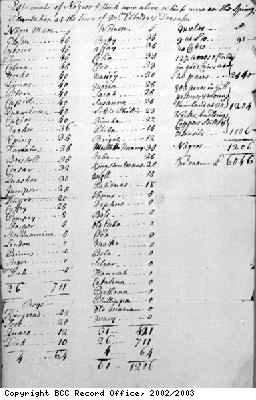
Description:
Document called Estimate of negroes and stock on Spring Plantation. Rebeccah Woolnough part-owned the Spring Plantation. She married John Hugh Smyth, of Ashton Court, Bristol, and the Smyth family owned Spring Plantation until 1825. The list gives the
name, occupation and fitness of each slave. The slaves marked * were jointly owned by Thomas French and John Hugh Smyth.
The language used to describe people of African descent in the 18th, 19th and 20th centuries is unacceptable in today’s terms. We cannot avoid using this language in its original context. To change the words would impose 20th century attitudes on history.
Creator: Spring Plantation
Copyright: Copyright BCC Record Office
Estimate of slaves and stock
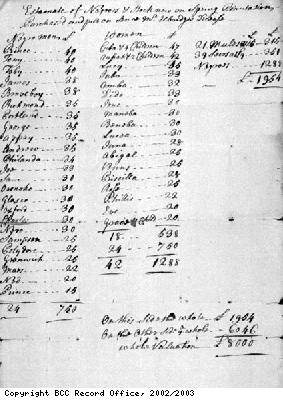
Description:
Document called Estimate of negroes and stock on Spring Plantation. Rebeccah Woolnough part-owned the Spring Plantation. She married John Hugh Smyth, of Ashton Court, Bristol, and the Smyth family owned Spring Plantation until 1825. The list gives the name, occupation and fitness of each slave. The slaves marked * were jointly owned by Thomas French and John Hugh Smyth.
The language used to describe people of African descent in the 18th, 19th and 20th centuries is unacceptable in today’s terms. We cannot avoid using this language in its original context. To change the words would impose 20th century attitudes on history.
Copyright: Copyright BCC Record Office
Sugar Cane and the Art of Making Sugar

Description:
Representation of the Sugar Cane and the Art of Making Sugar from Universal Magazine . 1750
Creator: Universal Magazine
Date: 1750
Copyright: Copyright BCC Record Office
Invoice for sugar shipped from Jamaica

Description:
Invoice for sugar shipped from Jamaica by Hibberts and Jackson and French to John Hugh Smith, 1762
Creator: Hibberts and Jackson and French
Date: 1762
Copyright: Copyright BCC Record Office
Map of Jamaica
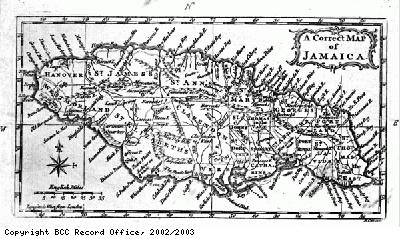
Description:
A Correct Map of Jamaica, by B Cole, showing the parishes and geographical features of the island. Trelawny Town is marked, the Maroon Community is shown on the map as being in St James’ Parish in the Blue Mountains. (The word maroon means escaped slave and comes from a Spanish word meaning mountaineers. The slaves escaped from their plantations to the mountains and formed independent communities of free people.)
Creator: B Cole
Copyright: Copyright BCC Record Office
Object ID:AC/WO 16(59)
Letter re paying tobacco proceeds

Description:
Letter to Captain Seton to pay tobacco proceeds to Edward Harford 1768. The Harford family had an interest in iron works which supplied the Guinea trade
Date: 1768
Copyright: Copyright BCC Record Office
Page 315 of 352 pages « First < 313 314 315 316 317 > Last »

